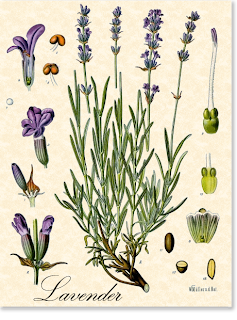Family: Lamiaceae
Common medicinal properties: Analgesic, AntiCancer, Antifungal, Antioxidant, Antiperspirant, Antirheumatic, AntiViral, Aromatic, Cardiac tonic cordial, Chlagogue, Cicatrisant, Cytophylactic, Deodorant/Perfumes, Diaporetic/Sudorific, Diuretic, Emmenagogue, Hypotensive, Insect repellents, Muscle Relaxant, Nervine, Parturient, Sedative, Splenic, Vermifuge, Vulnerary
Current Research:
Migraine. Some research suggests that rubbing 2 or 3 drops of lavender oil on the upper lip, so that the vapor is inhaled, might reduce migraine pain and nausea, and help stop the headache spreading.
Contraindications:
Sedative medications (Barbiturates) interacts with LAVENDER
Sedative medications (CNS depressants) interacts with LAVENDER
Parts Used: Flowers, leaves and stems
Constituents: volatile oil (up to 1.5%, containing linabol, linalyl acetate, lavendulyl acetate, terpinenol, cineole, camphor, borneol, pinene, limonene), tannins, coumarins (coumarin, umbelliferone, hemiarin), flavonoids, triterpenoids, rosmarinic acid
Folk applications:
Clothing smelling of lavender attracts love (thus the drawer sachets). Rub lavender against anything you want to attract a man. It is burned or smoldered to induce peacefulness and rest.It is carried to see ghosts.
Receipts
Blues Buster
Migraine Tincture
Peaceful Pleasure Tea

No comments:
Post a Comment